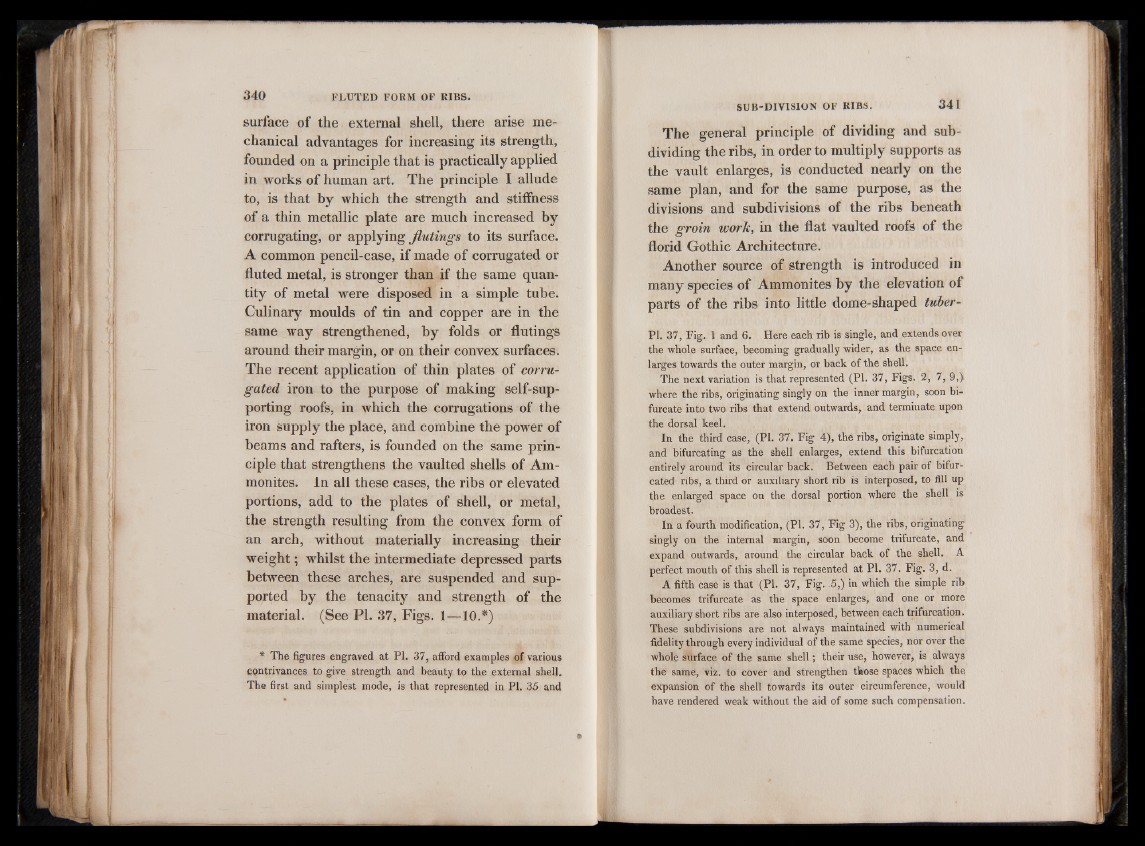
surface of the external shell, there arise mechanical
advantages for increasing its strength,
founded on a principle that is practically applied
in works of human art. The principle I allude
to, is that by which the strength and stiffness
of a thin metallic plate are much increased by
corrugating, or applying jiutings to its surface.
A common pencil-case, if made of corrugated or
fluted metal, is stronger than if the same quantity
of metal were disposed in a simple tube.
Culinary moulds of tin and copper are in the
same way strengthened, by folds or flutings
around their margin, or on their convex surfaces.
The recent application of thin plates of corrugated
iron to the purpose of making self-supporting
roofs, in which the corrugations of the
iron supply the place, and combine the power of
beams and rafters, is founded on the same principle
that strengthens the vaulted shells of Ammonites.
In all these cases, the ribs or elevated
portions, add to the plates of shell, or metal,
the strength resulting from the convex form of
an arch, without materially increasing their
weight; whilst the intermediate depressed parts
between these arches, are suspended and supported
by the tenacity and strength of the
material. (See PI. 37, Figs. 1— 10 .*)
* The figures engraved at PI. 37, afford examples of various
contrivances to give strength and beauty to the external shell.
The first and simplest mode, is that represented in PI. 35 and
SUB-DIVISION OF RIBS. 341
The general principle of dividing and subdividing
the ribs, in order to multiply supports as
the vault enlarges, is conducted nearly on the
same plan, and for the same purpose, as the
divisions and subdivisions of the ribs beneath
the groin work, in the flat vaulted roofs of the
florid Gothic Architecture.
Another source of strength is introduced in
many species of Ammonites by the elevation of
parts of the ribs into little dome-shaped tuber-
Pl. 37, Fig. 1 and 6. Here each rib is single, and extends over
the whole surface, becoming gradually wider, as the space enlarges
towards the outer margin, or back of the shell.
The next variation is that represented (PI. 37, Figs. 2, 7, 9,)
where the ribs, originating singly on the inner margin, soon bifurcate
into two ribs that extend outwards, and terminate upon
the dorsal keel.
In the third case, (PI. 37. Fig 4), the ribs, originate simply,
and bifurcating as the shell enlarges, extend this bifurcation
entirely around its circular back. Between each pair of bifurcated
ribs, a third or auxiliary short rib is interposed, to fill up
the enlarged space on the dorsal portion where the shell is
broadest.
In a fourth modification, (PI. 37, Fig 3), the ribs, originating
singly on the internal margin, soon become trifurcate, and
expand outwards, around the circular back of the shell. A
perfect mouth of this shell is represented at PI. 37. Fig. 3, d.
A fifth case is that (PI. 37, Fig. 5,) in which the simple rib
becomes trifurcate as the space enlarges, and one or more
auxiliary short ribs are also interposed, between each trifurcation.
These subdivisions are not always maintained with numerical
fidelity through every individual of the same species, nor over the
whole surface of the same shell ; their use, however, is always
the same, viz. to cover and strengthen those spaces which the
expansion of the shell towards its outer circumference, would
have rendered weak without the aid of some such compensation.